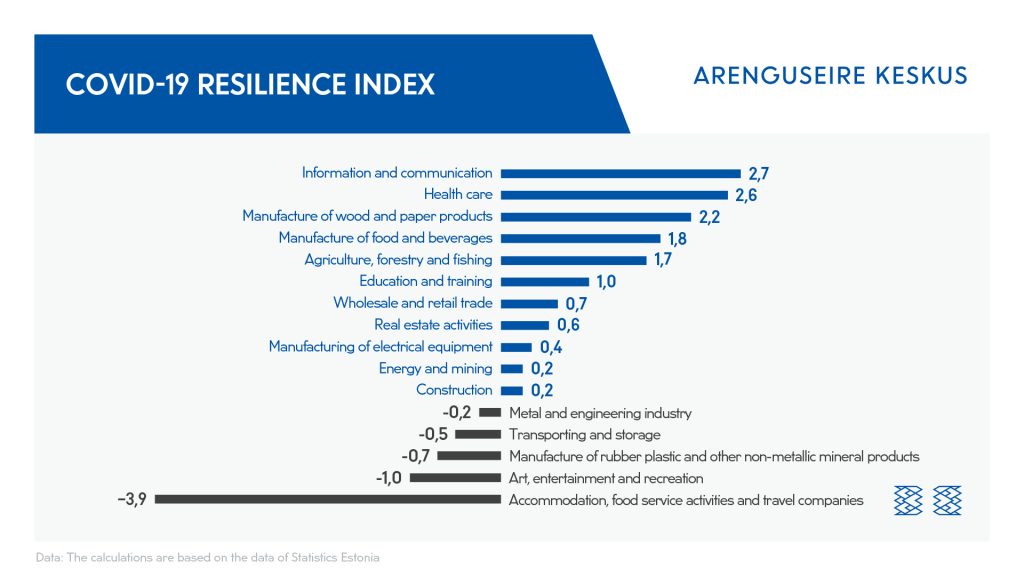The corona crisis is bringing new clients to private medicine
The reduction of planned treatment and extension of treatment waiting lists has made more people turn to private medicine, the report “The Impact of the Virus Crisis on the Estonian Economy. Scenarios up to 2030” by the Foresight Centre reveals. The increase in people’s health awareness accompanying the virus crisis and the tax exemption on the costs incurred for the promotion of health, introduced in 2018, have also fostered the growth of private medicine.

“The health care sector is a key branch in stabilising the epidemiological situation and managing the crisis,” Uku Varblane, expert of the Foresight Centre, said. “The health care sector has managed to hold up well so far thanks to its rapid response and reorganisation of work. The partial use of video and telephone consultations instead of physical meetings has helped slow down the spread of the virus and keep the health care system open as far as possible.”
Varblane said that the rise of virtual channels in providing health services was one of the changes accompanying the crisis, but it also involved new risks for example in the identification of people and the protection of health data. “The virus crisis may give a new impetus to the development of health technology and the pharmaceutical industry. Artificial intelligence, gene technology and personalized medicine broaden the opportunities for treatment as well as prevention activities, but they are also one of the central reasons for the rise in medical costs,” Varblane explained. “For example, there are good prospects for diagnostic robots which may reduce the burden of primary health care in the future.”
The development of data-driven services is hampered by the current data protection rules that also hinder the linking of the data of health care and the social system and bring about duplication of services. “In the future, for example, blockchain-based solutions may find use in the protection of health data,” Varblane said.
The report “The Future of Health Care in Estonia. Scenarios up to 2035” by the Foresight Centre shows that, in a longer-term, the funding model that is increasingly showing signs of collapse, the increasing average age of doctors and the shortage of doctors and nurses are the challenges to the Estonian national health care system. “There are many regions in Estonia where the average age of doctors is on the rise and young doctors do not wish to take up work in these regions. The availability of primary health care service will begin to deteriorate unless significant changes are undertaken,” Varblane noted.
In 2019, the health care sector in Estonia employed 4.3% of the labour force or 21,000 people. The sector provided 4.1% of the added value created in the Estonian economy or 1 billion euro. The monthly turnover of the institutions operating in the health care sector increased by a total of 6.4% compared to the year earlier, that is, by 48.2 million euro, from March to October this year. According to the COVID-19 resilience index developed by the Foresight Centre, the health care sector ranks second (with 2.6 points) by resilience to the crisis among the 17 economic sectors studied.
COVID-19 resilience index
The COVID-19 resilience index measures the extent to which economic sectors are affected by the coronavirus crisis. The index is based on various economic indicators of companies. The value of the index is between -5 (the largest negative impact) and +5 (the smallest negative impact). The index takes into account the changes in the turnover of companies (total turnover in March–August 2020 compared with the same period the year before) in the economic sector, changes in their number of employees in comparison to 2019 and the dynamics after the emergency situation, changes in labour expenses, and changes in the profit and investments of companies in comparison to the same period last year.

BACKGROUND
The calculations and figures of the surveys use the data of Statistics Estonia. The descriptions of development perspectives are based on the interviews with the representatives of sectoral associations and the focus group interviews conducted in cooperation with the OSKA (a system of labour market monitoring and future skills forecasting) research group of the Estonian Qualifications Authority. More about the scenarios for exiting the virus crisis here.
The Foresight Centre is a think tank at the Chancellery of the Riigikogu that analyses long-term developments in society and economy. The Centre conducts research projects to analyse the long-term developments in Estonian society and to identify new trends and development directions.
Latest news
-
10.11 2025Report: Estonia could learn how to control healthcare costs from the Netherlands
The expenses of the Estonian Health Insurance Fund significantly exceed its revenues, and the accumulated reserves will be depleted in the next five years. Other European countries in the same situation have cut healthcare services and increased people’s co-payments. According to the Foresight Centre’s new short report “Other countries’ experiences in managing healthcare budget deficits”, both solutions have worsened public health and deepened inequality.

 An independent think tank at the Riigikogu
An independent think tank at the Riigikogu 